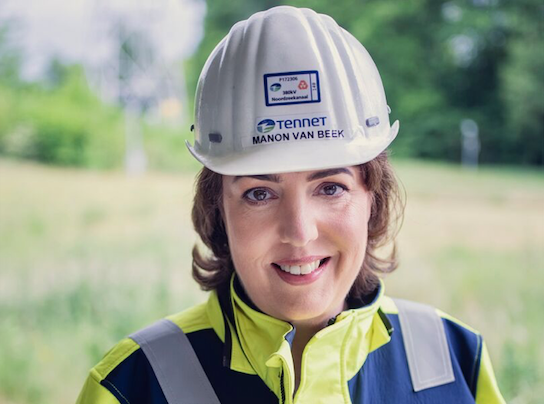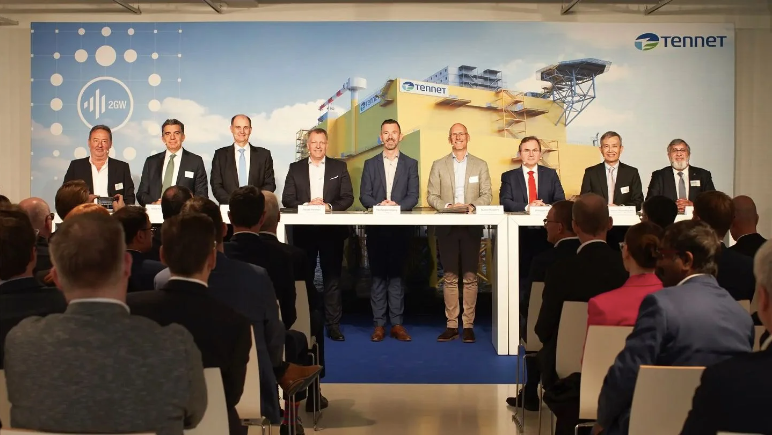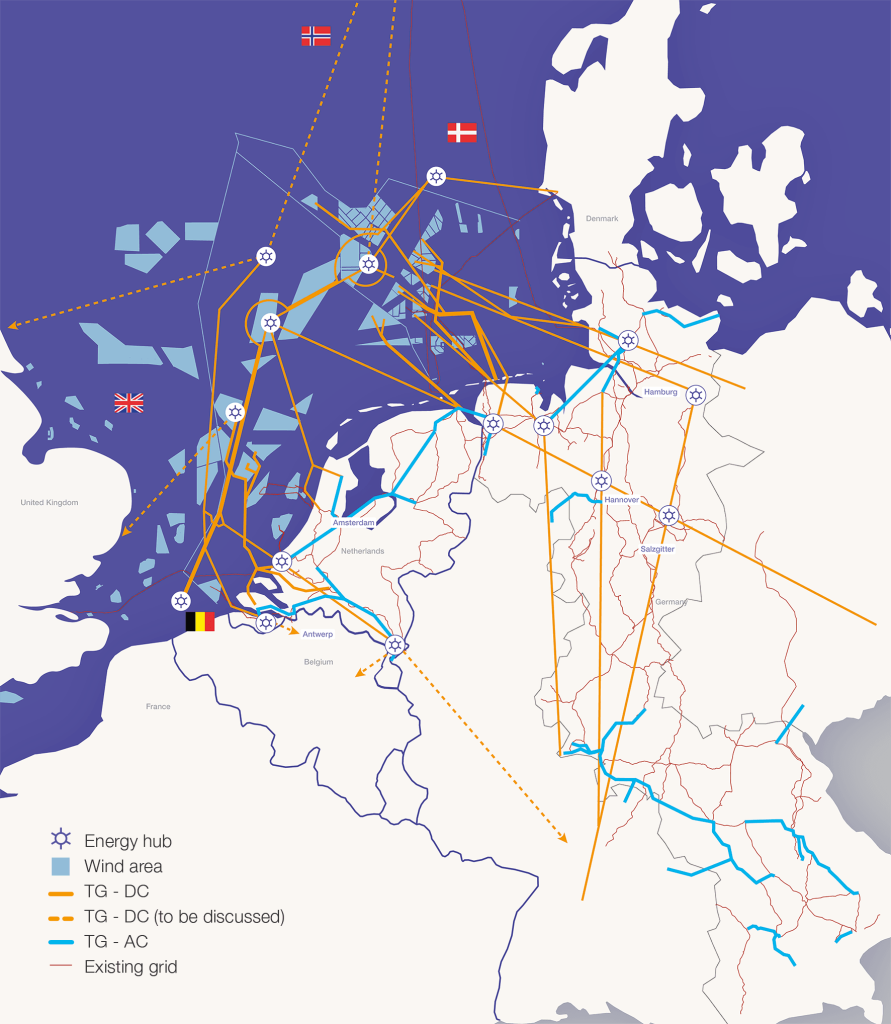
TenneT CEO Manon van Beek is today presenting TenneT’s plans for onshore and offshore electricity grids at the TenneT European Energy Conference in Brussels. The grid has been on everyone’s lips this week, at EU Sustainable Energy Week (EUSEW), Europe’s biggest event dedicated to renewables and energy efficiency, at Eurelectric’s annual Power Summit, and at the multiple other events being squeezed in before the EU machinery starts winding down for the summer.
Energy Monitor sat down with van Beek to discuss whether the grid is going to be able to cope with the accelerated deployment of renewables; whether permitting times have started coming down; what investments are being made and why; how the political and regulatory landscape is evolving; hydrogen; the internal energy market; supply chains; and talent. And whether, just maybe, we would be okay with a little less security of supply.
Is the grid finally getting the attention it needs? Can it cope with the accelerated deployment of renewables?
We need big-time acceleration when it comes to planning and permitting. If you look at how to bridge the distance from generation to consumption, what used to be 50–70km will in the near future be hundreds of kilometres if we go far offshore, for example.
I think we now realise that [grid] infrastructure is not only to enable the [energy] transition, it’s key to competitive advantage for Europe, in comparison with other parts of the world. Planning and licensing is still the most important factor to accelerate the delivery of the grid, next to supply chain and talent. There are still examples of projects where we end up spending up to 12 years in planning and permitting and we only need two years for the construction.
Read more from this author: Sonja van RenssenThere is a lot of talking going on about how to accelerate. We are pretty happy with the [EU] emergency rules [from last December] to accelerate permitting. I think we also know these rules will expire in summer 2024; we are now waiting for the new EU Renewable Energy Directive to make sure this acceleration gets a permanent base. The emergency rules contain very concrete measures – as for solar parks and wind farms, also grid investments can be seen as being in the “overriding public interest”. Especially in Germany this helps a lot. It’s nice to have all kinds of incentives around renewables generation but let’s not forget about grids – there is no energy transition without grids.

US Tariffs are shifting - will you react or anticipate?
Don’t let policy changes catch you off guard. Stay proactive with real-time data and expert analysis.
By GlobalDataOne more thing: when I think back to when we spoke a few years ago, I think on the ground, in the current context, there is more understanding of citizens and local politicians, and more willingness to help us speed up grid investments, also to avoid a severe energy crisis.
Have we seen an improvement in permitting and the build-out of grid infrastructure?
Maybe the best example is offshore. At TenneT, for offshore in particular, we go full speed ahead. In April, we announced an enormous investment programme, possibly the biggest ever approved on electricity grids – at least I’m not aware of a bigger one. We signed contracts with three Europe-based manufacturing consortia to deliver 11–14 offshore grid [connection] systems. We awarded more than €30bn ($33bn) for these 2GW-platforms and we also signed framework contracts – worth another €5–6bn – for HVDC [high-voltage direct current] cables.

The basis for such investments is always a government-approved road map. In this case, the government enabled us to award these contracts by appointing wind [development] areas. Now it’s 1–2 months later and we already see and hear from our suppliers that they are really starting to invest in new production capacity. With those tenders, we have translated our security and investment need into a market perspective.
If you look on land, in Germany, there is a huge effort [to accelerate permitting]. You can see it in the NordOstLink, where we now see we can speed up, but there is more to come and there is more needed. If I look on the Dutch side, you might have seen it, I wrote a letter – a full page in Het Financiele Dagblad – two weeks ago, which is basically a cry for help for 3,000 grid projects that are simply at a standstill. Next to permitting and licensing, on the Dutch side, we need to solve the nitrogen crisis to move forward. [Construction projects have been halted in the Netherlands because the building machines emit nitrogen and the country is far in excess of nitrogen pollution targets.]
I could say that [the nitrogen crisis] is even more critical [than permitting] right now.
How have TenneT’s investments evolved over the past few years?
The best indicator that investments are accelerating is that we see the company’s investment volumes climbing steeply year-on-year. When I joined TenneT four-and-a-half years ago, investments were at €2bn a year. The investments we landed last year – announced in March this year – were €4.5bn and we are moving towards €7–8bn this year. You can see it also in the awarding – €35bn and more were awarded just in April for offshore. On the other hand, the nitrogen crisis is blocking progress in the Netherlands, and we have been able to speed up because of temporary [permitting] exemptions. As I said before, we need these emergency measures to become permanent.
How has the political landscape changed?
I was in Esbjerg in May 2022, with the heads of government, where four countries [Germany, Belgium, Denmark and the Netherlands] committed to up to 150GW [of offshore wind in the North Sea] to be connected, and 65GW in 2030. TenneT is committed to 40 out of that 65 and we have awarded that.
I was also in Ostend in April this year, again with the heads of government. There they extended the Esbjerg group to all North Sea countries, including the UK. It [the roll out of renewables] has really become “Chefsache” [heads of state business]. You see not only the ministers for economic affairs and climate but also heads of government, and a much bigger group of countries now.
The Ostend Declaration doubled the offshore wind ambitions – but also the number of participants. Did it change anything for TenneT?
We were already speeding up. We are committed to the 40GW by 2030 and the Dutch and German governments are each committed to 70GW [of offshore wind in the North Sea] by 2045. What has changed in terms of TenneT is that we have now published a vision for a ‘Target Grid’ in 2045. This is our vision on how a meshed, direct current grid, on and offshore, including hubs, looks in 2045.

Our thinking on that has already been included in Germany’s latest Network Development Plan, which was developed jointly by all TSOs, and I expect the Dutch state – which is working on its view of the energy system of the future, to be published by the end of the year – will do the same.
The new LionLink – a 1.8GW connection from the Netherlands to the UK – is part of our Target Grid. The Dutch Government now supports this multipurpose interconnector with the UK and I think that’s a development. It’s become more generally understood that if you want to get to 70, 100 or 150GW [of offshore wind] you need to start thinking in terms of a meshed grid [rather than radial connections of windfarms to single countries]. It will be better for biodiversity too because you will ultimately use less sea or land.
I think you also saw with Ostend that it has become clear that if we want to counter Russian aggression and avoid energy crisis, we need to work together, including with the UK. I think this EU-UK cooperation has really restarted. The LionLink was launched with the full support of the UK and Dutch governments. It will connect a future 2GW platform directly to the UK [as well as Dutch] shore.
You say the Ukraine War has reignited UK-EU cooperation and helped public acceptance of grid investments. Has our notion of energy security evolved? As a transmission system operator (TSO), your primary mandate is to provide security of supply. Could we live with slightly less of it, say having electricity 99.9% instead of 99.9999% of the time?
We discussed exactly this question earlier this month, at a lunch with several captains of industry. Could we make do with less? I think this group was not yet there.
It’s all coming together today: the energy transition, energy security and affordability. If we want to have welfare, prosperity and economic growth here in Europe, we also need affordable electricity – that is very much becoming part of the debate and rightfully so. We are working more closely with industry – in the Netherlands it accounts for half of electricity use and it is the largest-growing customer segment because of electrification. What we see is that it’s not [just] about reducing emissions, but also about the European internal market – we need favourable economic conditions to attract or retain industry. The key words are “perspective” and “predictability”. We need to be asking ourselves: how does our energy system look in 2045? Industries need that to prepare, and electrify, but also to attract private finance.
We are not there yet. Renewables and offshore wind in particular are a huge chance for Europe. We can build that green powerhouse in the North Sea and have a reliable, affordable energy supply. The challenge is that the low-hanging fruit has been picked and now we have to crack the hard nuts. The lead time for electricity grids is significantly longer than for renewables generation, so we need to know where we are going well beyond 2030 – 2030 is yesterday.
The energy crisis has also introduced government intervention in energy markets that is unprecedented in recent times. Are we at risk of fragmenting rather than further building out the European energy market?
I talk a lot about “leading in ambiguity”. The internal energy market is more important than ever. If you look at our vision, in 2045, there are way more imports and way more exports. Our North Sea is really a precedent of how to integrate design and regulation. You can do that between individual governments but also with a European agenda in mind. The Ostend meeting has really helped there. It’s a new phase in the energy transition: if we want to reach a climate-neutral economy, or a more renewable energy system, we really need to plan across borders. Renewables work better if you integrate geographically larger areas. Cross-border rules and regulations need more discussion and implementation – a lot is still missing.
Is there a hydrogen hype?
No, it’s more than a hype. We still very much believe electrons and molecules are friends in the energy transition. Our Target Grid focuses on electricity but when we look into the future and see 70GW of offshore wind, we also think 20GW or so of that will be green hydrogen. We still believe renewable electricity is ideally used directly in the form of electrons – it’s the most sustainable and efficient. If you build electrolysers, they need to be close to renewables sources, to avoid huge unnecessary investments into the grid. The converted hydrogen should then be transported through pipelines if it is needed far from the renewable sources.
Keep up with Energy Monitor: Subscribe to our weekly newsletterIf you look at the acceleration of a hydrogen network, I think we’re not there yet, but I do think it’s essential. For example, in the Netherlands, we will be landing green electrons big time at the end of this/early next decade and we don’t have time to reinforce all the high-voltage lines onshore, so we either need to make sure we use electrons where they arrive or build an electrolyser. Also, electrolyers alone won’t do the trick – you need them at the right time and in the right place. It’s a message we continue to underline. It’s more understood than two years ago – at the political and industrial level, where huge energy intensive investment decisions are going to sites where renewables are close – but we’re not there yet.
You said at the start that permitting is the main challenge, followed by the supply chain and talent.
The answer to supply chain scarcity is long-term partnerships so that you enable the supply chain to work with you to invest. We see it – when you speak to GE, Hitachi, Siemens Energy, the ones we awarded in April – some of them already say, just 1–2 months later, they are hiring another 150 people. If we give a perspective of ten years or more to the market, they will invest.
Last but not least, is talent. We have been able to have a net growth of around 800 people a year at TenneT; we have doubled the company now and we want to be around 10,000 in the very near future. For context, in the Netherlands we think we need 30,000 people in the energy transition. We need to educate and train them and think about how to attract them: we are looking for high-voltage heroes! We have run campaigns and we are talking to the minister of education. This is a long-term agenda item and I think TenneT can do a lot; most critical is to bring the supply chain with us.
How dependent on China are you for your supply chain?
For HVDC, the three big manufacturers are Europe-based – Siemens Energy, Hitachi and GE – the names sound foreign, but they all have their main manufacturing capacities in Europe. So here Europe has the possibility to keep a leading position, rather than fight for one. This industrial ecosystem for offshore wind power is really an advantage compared with the US, for example.
Finally, how do you see the shifting political landscape in Europe and what does it mean for the energy transition and your plans? What should be on the agenda of the European Commission’s big infrastructure event planned for September?
What we need is clear investment frameworks with a meshed offshore grid, across borders. This is super urgent – if those frameworks take too long, we risk missing out on a whole generation of offshore platforms. On the politics, I don’t see many good alternatives to increasing renewables. The North Sea with its shallow waters and plentiful wind can make us less dependent on volatile prices and fossil fuel imports, but we also have to take our citizens along. It all starts with a vision. People feel they run from crisis to crisis, project to project, issue to issue; it’s super important we start with the end in mind and take our citizens and voters with us.



